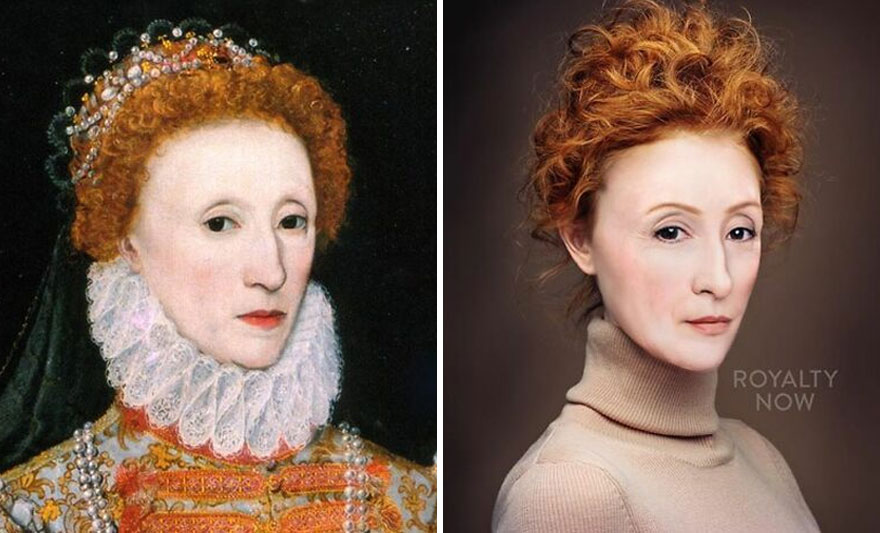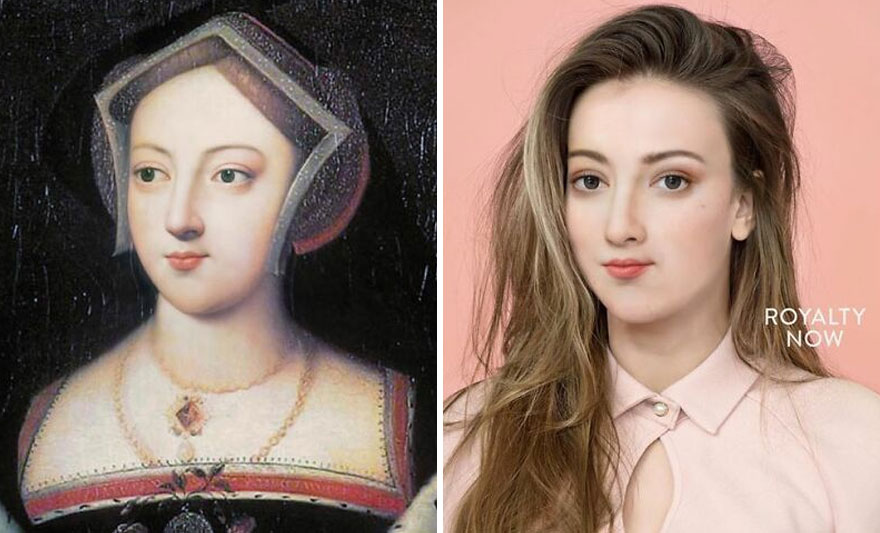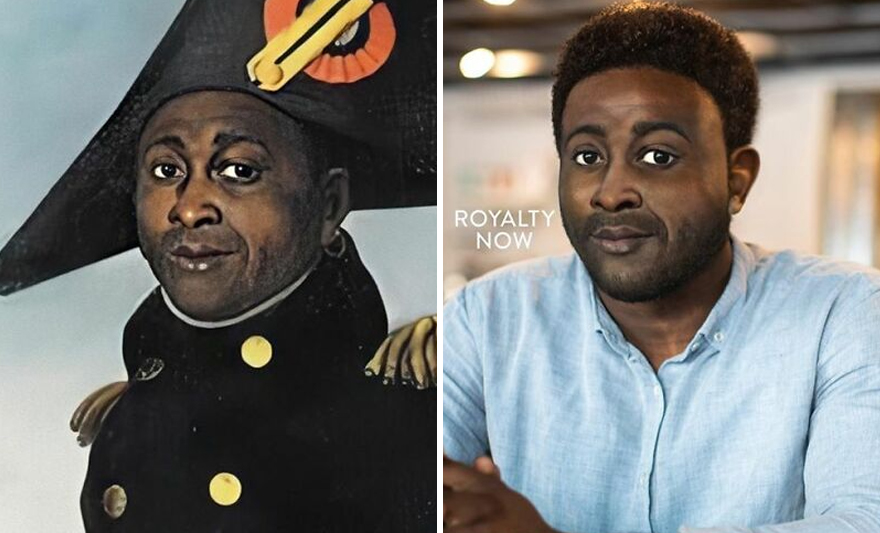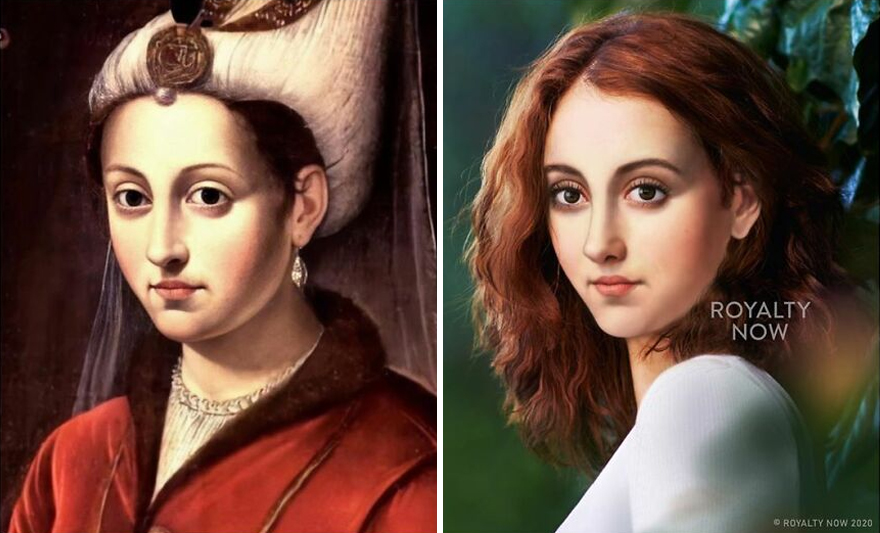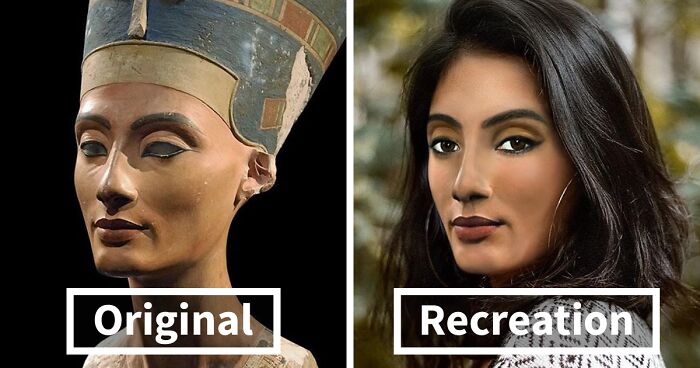
Here’s What Nefertiti And Other Historical Figures Would Look Like Today (25 New Pics)
Interview With ArtistAll of you history, anthropology, and archeology-loving Pandas out there, hang on to your seats. Have we got a treat in store for you! If you’ve ever wondered what historical figures would look like if they were alive right here and now, then look no further—Becca Saladin has you covered. Becca, who works as a full-time graphic designer, created the Royalty Now series as a way to bring the past into the present and to help us look at history from a new angle. Check out Becca’s newest historical reimaginings below and remember to upvote your faves. Let us know which of the artist’s pieces you enjoyed the most, too.
Becca told Bored Panda that each image takes her from 4 to 5 hours to create. Sometimes, even longer. "Many people think I just use an app or just simply face-swap them, but it's much more complex than that in order to make it look as realistic as possible," she said. Read on for our full interview with the graphic designer.
Be sure to visit Becca’s social media if you loved her art and have a gander at her previous posts on Bored Panda here: Part 1 and Part 2.
More info: Instagram | TikTok | Facebook | Etsy | Patreon
This post may include affiliate links.
Nefertiti
This bust of Nefertiti (believed to have been sculpted during her lifetime) is famous for its grace and beauty. Nefertiti lived from approximately 1370 - 1330 BC. She was an Egyptian queen and the wife of Akhenaten, an Egyptian Pharaoh. Akhenaten is famous for his attempt to transition Egypt into a monotheistic society (worshipping only the sun god, Aten), instead of a polytheistic one.
Elizabeth I
Cyrus The Great
Cyrus II of Persia was the founder of the Achaemenid Empire, which at its height encompassed the areas of modern-day Iran, Egypt, Turkey, and parts of Afghanistan and Pakistan. During a reign lasting 30 years, Cyrus grew his empire by conquering surrounding territories. Something Cyrus is famous for is that he respected the customs and religion of each land he conquered, a move unprecedented at the time. This policy was a very successful model for establishing governments that kept the territories under control even after his armies had left. He is a well-recognized figure for human rights, military strategy, and politics. Cyrus even makes an appearance in the Old Testament (Hebrew Bible). A cult-like figure for modern Iranians, his tomb is a gathering point for those that revere him. He was alleged to have died in battle, but his Empires’ influence still lives today.
"I use Photoshop, so I end up finding a picture that will work underneath (similar skin tone, hair color, facial angle), and then I start to add the features. Usually I copy and paste the original statue or image over to the new one for reference, and then I start photo-compositing new images onto it," Becca went into detail about her artistic process.
"For instance, I find a new photographic nose and morph it to the shape of the portrait nose to add realism. Then I repeat this with the rest of the features. The final image usually turns out to be mostly photo-composite with some digital drawing on top of it."
Marie Antoinette
Ludwig Van Beethoven
Ludwig van Beethoven (1770-1827, shown here at age 49 in 1820) doesn’t need much of an introduction. A famous composer and pianist, his music is some of the most performed classical music in the world. His work spans both the classical period and the romantic periods of classical music. Moving to Vienna at the age of 21 and gained a reputation as a virtuoso. Scholars generally divide Beethoven’s work into three periods: Early, Middle, and Late. The Early period can be seen as him honing his craft, and the Middle period shows individual deviation from the Classical styles of Mozart. During the Late period (which lasts until his death in 1827), his deafness increases, but it is widely accepted as his most innovative time. Written in his last years, his late string quartets of 1825–26 are amongst his final achievements. After some months of bedridden illness he died in 1827. Beethoven's works remain mainstays of the classical music repertoire
Queen Nzinga
Nzinga was the Queen of the Kingdom of Ndongo and the Kingdom of Matamba in the 17th century, in the area of modern-day Angola. Born into the ruling family in 1583, her father trained her in military and political tactics from a young age. While her older brother was ruling the Kingdoms, he asked Nzinga to become the ambassador to Portugal for him, as the Portuguese had begun to colonize and infringe on their native area. When Nzinga assumed power over the kingdoms after her brother died, it was during a period of unprecedented growth in the African slave trade. The Portuguese continued to agitate and break treaties, taking slaves and other valuables. Nzinga was an astute and super-intelligent leader and often bent the allegiances of the Europeans to her advantage. Forging an alliance with the Dutch, she was able to defeat the Portuguese and drive them out. She also made her kingdom a safe haven for runaway slaves. Her reign lasted 37 years - she is considered a legendary figure in Angola to this day.
We were also interested to find out what keeps Becca passionate about history. She revealed that she finds out something new about history nearly every day while conducting research for her portraits, reading, and running her Instagram and TikTok accounts.
"I think it's just really cool to keep learning and increasing my depth of knowledge on certain subjects. I would say to graphic designers or artists to just keep going—everything is a learned skill. I made portraits a year ago that I'm embarrassed by, but I keep growing as an artist. It's nice to see your work after you've worked hard at it and know you've grown. So I would just tell them to keep at it and keep practicing," she gave some wholesome advice to anyone who wants to follow in her footsteps.
Catherine Of Aragon
This portrait is disputed to be her (it may in fact be Mary Rose Tudor)
Aristotle
One of the most famous thinkers of all time, Aristotle (384-322 BC) contributed significantly to human knowledge. His reach touches logic, biology, ethics, aesthetics, and more. We don’t have any contemporary descriptions of his coloring, but luckily we have several surviving busts of his looks - of course this means estimating the hair and eye color, which is unknown. This work is in the Uffizi gallery, and is a Roman copy of the Greek original. Aristotle was taught by none other than Plato, and he spent 20 years as a student and later as a teacher at Plato’s Academy. Of his approximately 200 works only 31 survive. It is theorized that the surviving writings, because of their jumbled and dense structure, were meant to be lecture notes for his teaching rather than finished works. His writings were lost for many years after his death, and only after 300 years (in 30 BC) did Andronicus of Rhodes group and edit Aristotle’s works. Aristotle remains one of the most influential thinkers of all time, and contributed greatly to history.
Erzsébet Báthory
Countess Elizabeth Báthory (Erzsébet Báthory) (1560 –1614) was a Hungarian noblewoman. She has been labeled as the most prolific female serial killer in history (documented, at least). She was accused at trial of torturing and murdering hundreds of young girls & women between 1590 and 1610. The stories of her sadistic murders were verified by the testimony of more than 300 witnesses and survivors, as well as many bodies. Eyewitnesses reported seeing her carrying out severe beatings, mutilation, burning, freezing, and starving girls to death. Because of her family’s status, she was not executed but rather imprisoned for the remainder of her life in Cachtice Castle. Folklore (although unsubstantiated) about Báthory has followed her throughout history, saying she bathed in the blood of virgins. Her legacy certainly lives on in modern popular culture.
Becca started reimagining historical figures using her skills as a graphic designer around a year and a half ago. What started as a hobby has since blossomed into something much bigger, as the 262k fans following the Royalty Now Instagram account will let you know.
Ever since she was a child, Becca has been interested in art. She was always painting and sketching when she was small. She became interested in history because her parents would read to her a lot while her mom would do art and science projects with her. So it’s safe to say that she’s been on the path to what she’s doing now since very early on in life.
“The first book my dad read to me about history was a fictionalized young adult version of the Anne Boleyn story. I became obsessed with Tudor history after that. I also loved Pompeii, ancient Egyptian mummies, and anything else that helped me feel close to the people of the past. I think that is why I enjoy making the recreations so much,” the graphic designer said earlier.
Yoruba Ruler - Bronze Ife Head
Although it’s not known who this sculpture is a depiction of, this famous Bronze Head from Ife, also known as the Ife Head, is one of eighteen copper alloy sculptures that were unearthed in 1938 at Ife in Nigeria, the religious and former royal centre of the Yoruba people. Believed to represent a Yoruba Ruler, It was probably made in the thirteenth-fourteenth century AD, before any European contact had taken place with the local population. The realism of the sculptures is amazing and some of the only photorealistic depictions created in African art.
.
The Ife Head was likely made under the patronage of King Obalufon II, whose bronze likeness shares stylistic features with this work. These bronze heads are evidence of additional trade since Ife-made glass beads have been found widely in West Africa. The detailed work shows what are believed to be tribal markings on the face. I conducted some research into this, and found that these same tribal markings are still observed in some parts of Africa, although this practice is becoming much more rare, so I have not included him in my depiction here.
George Washington
Washington was an American political leader, military general, statesman, and founding father who served as the first president of the United States from 1789 to 1797. Before becoming the president, Washington was a leader in the nation’s Revolutionary War for Independence. Washington has been called the "Father of His Country" for his manifold leadership in the formative days of the new nation. Washington owned slaves, and, in order to preserve national unity, he supported measures passed by Congress to protect slavery. He endeavored to assimilate Native Americans into Anglo-American culture but combated indigenous resistance during occasions of violent conflict. He has been memorialized by monuments, art, geographical locations, stamps, and currency, and many scholars and polls rank him among the greatest U.S. presidents.
Mumtaz Mahal
Mumtaz Mahal was the Empress consort of the Mughal Empire from 1628 to 1631 as the chief wife of Mughal emperor Shah Jahan. She is most famously known as the woman for whom the Taj Mahal was built to act as a tomb. Cited as one of the Wonders of the World, the monument is seen as one of undying love and devotion. Mumtaz (born Arjumand Banu Begum) was born to a Persian noble family in 1593, and became betrothed to Shah Jahan at the age of 19. The couple went on to have 14 children - the last of which caused Mumtaz’s death. Unfortunately there are no known contemporary portraits of Mumtaz, so I am working from a 17th-18th century likeness. Mumtaz lived an unprecedented lavish and luxurious lifestyle. She had a massive allowance for clothing and travel. However, she was more than a vapid character of history - she was Shah Jahan’s trusted advisor and confidante. On her advice, he would forgive enemies and even commute death sentences. She intervened on behalf of the poor and destitute, and was a patron of arts and culture throughout the empire.
Beautiful enough to make it even more believable that Shah Jahan WOULD build the Taj Mahal for her tomb!
She came up with the idea to reimagine historical figures when she was looking at a portrait of Anne Boleyn one day. That’s when Becca started thinking about what Boleyn would look like today because she doesn’t look very lifelike in her portraits.
“I saw someone else on Reddit try something similar with Tudor wives and I'd seen the recreations of Roman statues. I've always loved Photoshop and what a powerful tool it is, so I decided to try and recreate some of my own and then just kept going,” she went into detail about how she decided to start her Royalty Now project.
Lady Jane Grey
Jane was only 17 years old when she was executed in 1554. She is known commonly as “The Nine Days' Queen” - ruling England and Ireland between the 10th and 19th of July, 1553. Before the death of Edward VI, he nominated the Protestant Jane and her descendents to be his heirs, leaving his Catholic half-sister Mary out of the succession. King Henry VII was Jane’s great-grandfather, putting her squarely in the running as a legitimate heir. Unfortunately Edward passed away before his change to the succession could be ratified through Parliament, leaving it on legally shaky ground, and the slow speed of news travel meant that Mary never heard of the change until Jane was already on the throne. Viewing Jane as a usurper, Mary quickly raised an army and marched on London as Jane was awaiting coronation. After Mary I was installed as queen on July 19th, Jane was eventually deemed too dangerous to the crown to live. Both Jane and her husband Lord Guildford Dudley were executed on the 12th of February, 1554. Jane’s life being cut short was a great tragedy - she was known as one of the most learned young women of her day.
She is SO dang pretty. She doesn't look *Super* plastic, but if she was in real life, she would be beautiful!
Dido Elizabeth Belle
Born into slavery in the West Indies in 1761 to a woman named Maria Belle, Dido Elizabeth Belle was the illegitimate daughter of Sir John Lindsay, a British naval officer. It can only be assumed this relationship between Lindsay and Maria Belle was not consensual, however the exact arrangement is lost to history. Lindsay returned to England with Dido after the war in 1765. Lindsay took Dido to be raised by his Aunt and Uncle, William & Elizabeth Murray, the count and countess of Mansfield. The Murray family raised Belle as an educated woman along with their niece and Dido's cousin, Lady Elizabeth Murray. The portrait I’ve worked from here in the full version shows both Elizabeth and Dido together, as relations but not quite on equal footing. The social conventions of Mansfield's household are somewhat unclear. When the Mansfields were entertaining, Belle did not eat with the guests. A 2007 exhibit at Kenwood suggests that she was treated as "a loved but poor relation", and therefore did not always dine with guests. He said Belle joined the ladies afterwards for coffee in the drawing-room. However, other historians think she was treated as an equal based on the luxuriousness of her allowance and wardrobe. The very intelligent Dido was given responsibilities such as managing parts of the household and helping her uncle with correspondence. Belle’s life is such an interesting example of how race and illegitimacy was handled in 1700s England.
.
Would anyone like a print of this work? Please message me if so. I haven’t listed it in the Etsy shop yet (Link in bio) but would be happy to arrange for prints if there’s a demand for Dido.
Jane Seymour
Mary Boleyn
Mary Boleyn was known as the beauty of the Boleyn family. She previously had an affair with Henry VIII before her younger sister Anne married him.
It was just an affair and not a marriage, because she was already married. Ironically, I believe she got pregnant by Henry—-and had a strong and healthy son that he, unfortunately, couldn’t claim as his own—-as opposed to the sickly one he could claim!
Cleopatra
Henry Viii
Toussaint L’ouverture
Toussaint L’Ouverture (1743 – 1803) was a Haitian general and best-known leader of the Haitian Revolution. L'Ouverture was a slave in Saint-Domingue (later the country of Haiti) until the age of 33. Beginning in 1789, free people of color of Saint-Domingue were inspired by the French Revolution to seek more rights and equality. L’Ouverture joined the rebellion and quickly worked into the position of General. Allied with the French, he gradually established control over the island of Saint-Domingue. He put forth an autonomous constitution for the colony in 1801, which named him as Governor-General for Life, against the wishes of French leader Napoleon Bonaparte, causing a huge amount of friction. In 1802, he was invited to a parley by the French and was arrested under false pretenses. Deprived of food and water in a French jail cell, he died in 1803. Though L’Ouverture died before the final stage of the revolution, his achievements set the grounds for the black army's absolute victory. Suffering massive losses in battles at the hands of the Haitian army and battling yellow fever, the French were forced to withdraw from Saint-Domingue. The Haitian Revolution continued under L’Ouverture's lieutenant, Jean-Jacques Dessalines, who declared independence on 1 January 1804, thereby establishing the sovereign state of Haiti.
Akhenaten
Akhenaten was an ancient Egyptian pharaoh born in 1380 BCE that reigned circa 1353–1336 BCE. Before the fifth year of his reign, he was known as Amenhotep IV. One of his wives was the famous Nefertiti (a previous subject of Royalty Now). Akhenaten and Nefertiti were known for a religious revolution, during which they cast away the multiple Egyptian gods and began a monotheistic religion centered around the sun god, Aten (the reason for the name change from Amenhotep to Akhenaten). The new religious ways were not widely accepted by the Egyptian people or nobles, and gradually returned to normal after his (supposed) son King Tutankhamun became the leader. Akhenaten reigned at what was arguably the wealthiest period of Ancient Egyptian history, known now as the Amarna period. The art of the Amarna period deviated drastically from the previous art style - it was much less formal and full of curvier, more realistic portrayals of the rulers, which is why we have such beautiful portraits of both Akhenaten and Nefertiti. Compare their portraits to previous subject Hatshepsut, and you will see the stylistic difference.
Catherine De’ Medici
Catherine (1519 – 1589), was an Italian noblewoman from the famous and powerful Medici family. She was Queen of France from 1547 until 1559, alongside King Henry II until his death in 1559. Catherine and Henry had three sons - Francis, Charles, and Henry - and she watched them all become King in succession to one another. The three sons reigned in an age of almost constant civil and religious war in France. The problems facing the monarchy were complex and daunting, but Catherine was able to keep the monarchy and the state institutions functioning even at a minimum level. Intelligent but ruthless, she resorted to hard-line policies that included excessive persecutions and violence, leading the people of France to become extremely disillusioned with the monarchy. She is known for doing anything for her family and for the Valois line to remain on the throne. This is demonstrated by the amusing tidbit that Catherine had a group of elite female spies called the “Flying Squadron” who did her bidding. Without Catherine, it is unlikely that her sons would have remained in power. According to Mark Strage, one of her biographers, Catherine was the most powerful woman in 16th-century Europe.
Very pretty older woman who looks like she would’ve been strikingly pretty when she was young.
Hürrem Sultan
Hürrem Sultan, also known as Roxelana, was the chief consort and legal wife of the Ottoman Sultan Suleiman the Magnificent. She became one of the most powerful and influential women in Ottoman history and a prominent and controversial figure during the era known as the Sultanate of Women. Born in what is now modern-day Ukraine, Hurrem was originally a captive from a slave raid in her home country of Ruthenia. She entered the Imperial Harem of Suleiman (a former Royalty Now subject). Famously, Hurrem rose through the ranks of the harem, catching the special attention of Suleiman. The pair fell in love, and breaking with Ottoman tradition, Suleiman made Hurrem his legal wife and the first imperial consort to receive the title of Haseki Sultan. The pair had six children. Hurrem is famous for not only being beautiful and the wife of the great Sultan, but also for being smart and active in the affairs and direction of the empire. She acted as Suleiman’s chief advisor and corresponded with politicians on matters of state both foreign and domestic.
Gorgeous. Absolutely stunning but her hair texture would be totally different. Have you seen the wigs found in Egypt especially the one most recently? Hard to tell wiu Nefertiti’s headdress but poor to assume this would have been her hair texture. Look it up ... the hair was coils and often braided like in sister locks or box braids :)
Suleiman The Magnificent
Suleiman I, known as Suleiman the Magnificent in the West and Kanunî Sultan Süleyman in his realm, was the longest-reigning Sultan of the Ottoman Empire from 1520 until his death in 1566. Under his rule, the Ottoman state ruled over at least 25 million people - what many scholars call the apex of the Empire. Suleiman and his military were a force to be reckoned with - shortly after ascending the throne, he began campaigns against Christian powers of Europe and the Mediterranean. Changes made by Suleiman to the Empire included major overhauls of society, education, taxes, and law.
Elizabeth Of York
Elizabeth was the wife of King Henry VII and the mother to the future King Henry VIII. Their union began the “Tudor” period as we know it. She married Henry in 1486 after his victory at the Battle of Bosworth Field against the other claimant to the throne, Richard III, which marked the end of the Wars of the Roses. The War of the Roses was one of the most tumultuous periods of English history, involving two main warring factions, the Yorkists and the Lancastrians. Both sides were vying for the throne and both sides had legitimate claims. The marriage of Elizabeth of York and Henry VII (of Lancaster), marked a political union that worked as intended - to show that the war was over, and that the two sides had joined. Obviously there is much more nuance to the events, but that is the cliff-notes version.
Shah Jahan
Shah Jahan was the 5th Mughal emperor, coming after Bâbur, Humâyûn, Akbar, and Jahângîr, his father (hopefully all will be created as future subjects!). As a child, he was very intelligent and showed promise very early in life. Taking over the throne in 1628, Shah Jahan is considered to be one of the most successful Mughal emperors - reigning for 30 years. The empire thrived under his long rule. He is most famously known for constructing the Taj Mahal for his late wife Mumtaz Mahal and being a great constructor of monuments.
An interesting excersize. Bearing in mond we are see these people through the artists filter (Their skill, views on the subject and contemporary views of beauty.... and then again through a different artist's filter. The more recent one gave everyone a pretty similar makeup job.
Yes, many of the original portraits would have been done in the fashionable style of the time and not necessarily a very accurate "warts and all" depiction.
Load More Replies...An interesting excersize. Bearing in mond we are see these people through the artists filter (Their skill, views on the subject and contemporary views of beauty.... and then again through a different artist's filter. The more recent one gave everyone a pretty similar makeup job.
Yes, many of the original portraits would have been done in the fashionable style of the time and not necessarily a very accurate "warts and all" depiction.
Load More Replies...
 Dark Mode
Dark Mode 

 No fees, cancel anytime
No fees, cancel anytime 














